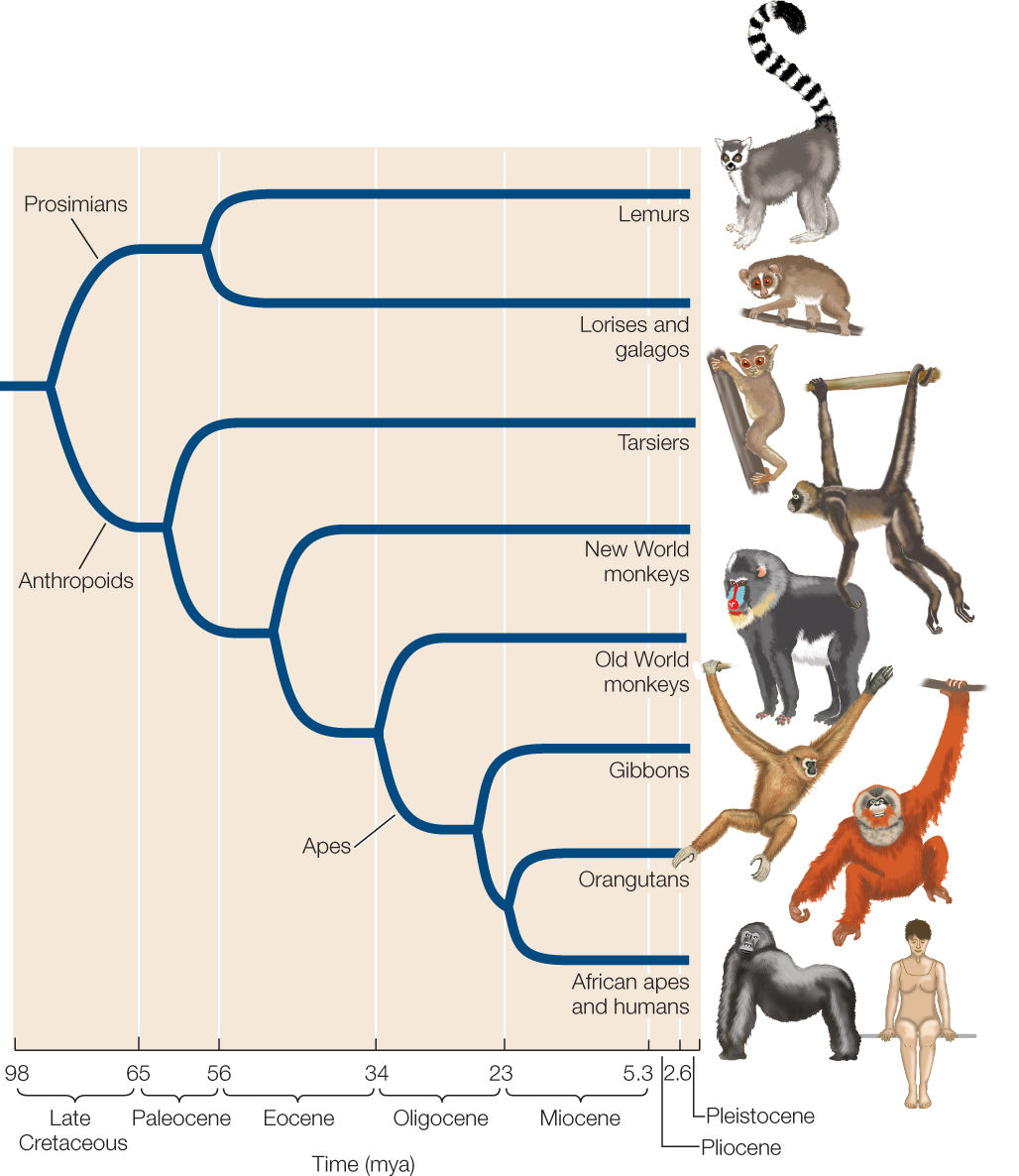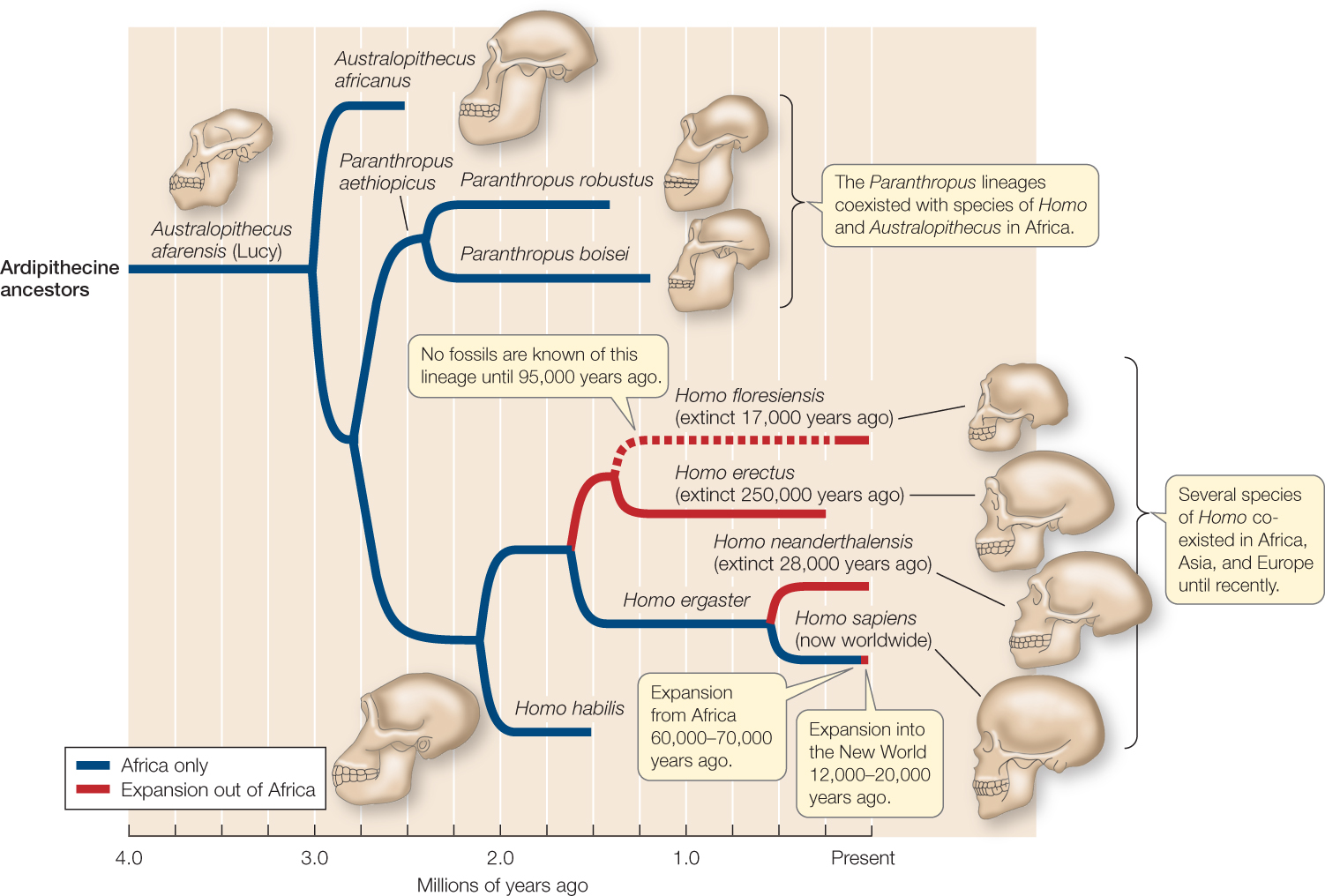CONCEPT23.7 Humans Evolved among the Primates
The primates evolved from a lineage of relatively small, arboreal, insectivorous eutherians. Grasping limbs with opposable digits are one of the major adaptations to arboreal life that distinguish primates from other mammals. Primates underwent extensive evolutionary radiation throughout the Tertiary (FIGURE 23.54).

Two major lineages of primates split late in the Cretaceous
About 90 million years ago, late in the Cretaceous period, the primates split into two main clades: the prosimians and the anthropoids. Prosimians—lemurs, lorises, and galagos—once lived on all continents, but today they are restricted to Africa, Madagascar, and tropical Asia. Most prosimians are arboreal and noctural. There has been a remarkable radiation of lemurs on Madagasgar, where there are also diurnal and terrestrial species. Tarsiers were once considered prosimians as well, although today we know that they are more closely related to monkeys and apes than to lemurs, lorises, and galagos.
The second primate lineage, the anthropoids—tarsiers, New World monkeys, Old World monkeys, and apes—began to diversify shortly after the mass extinction event at the end of the Cretaceous, in Africa and Asia. New World monkeys diverged from Old World monkeys and apes slightly later, but early enough that they might have reached South America from Africa when those two continents were still close to each other. All New World monkeys now live only in South and Central America, and all of them are arboreal. Many of them have long, prehensile tails with which they can grasp branches. Many Old World monkeys are arboreal as well, but a number of species are terrestrial. No Old World primate has a prehensile (grasping) tail.
About 35 million years ago, a lineage that led to the apes separated from the Old World monkeys. Between 22 and 5.5 million years ago, dozens of species of apes lived in Europe, Asia, and Africa. The Asian apes (gibbons and orangutans), African apes (gorillas and chimpanzees), and humans are their modern descendants.
Bipedal locomotion evolved in human ancestors
About 6 million years ago in Africa, a lineage split occurred that would lead to the chimpanzees on the one hand and to the hominid clade, which includes modern humans and their extinct close relatives, on the other.
The earliest protohominids, known as ardipithecines, had distinct morphological adaptations for bipedal locomotion (walking on two legs). Bipedal locomotion frees the forelimbs to manipulate objects and to carry them while walking. It also elevates the eyes, enabling the animal to see over tall vegetation to spot predators and prey. Bipedal locomotion is also energetically more economical than quadrupedal locomotion (walking on four legs). All three advantages were probably important for the ardipithecines and their descendants, the australopithecines (FIGURE 23.55).

The first australopithecine skull was found in South Africa in 1924. Since then australopithecine fossils have been found at many sites in Africa. The most complete fossil skeleton yet found was discovered in Ethiopia in 1974. The skeleton, approximately 3.5 million years old, was that of a young female who has since become known to the world as “Lucy.” Lucy was assigned to the species Australopithecus afarensis. Fossil remains of more than 100 A. afarensis individuals have since been discovered, and there have been recent discoveries of fossils of other australopithecine species that lived in Africa 4–5 million years ago.
Experts disagree over how many species are represented by australopithecine fossils, but it is clear that multiple species of hominids lived together over much of eastern Africa several million years ago. A lineage of larger species (weighing about 40 kilograms) is represented by Paranthropus robustus and P. boisei, both of which died out between 1 and 1.5 million years ago. A lineage of smaller australopithecines gave rise to the genus Homo.
Early members of the genus Homo lived contemporaneously with Paranthropus in Africa for about a million years. Some 2-million-year-old fossils of an extinct species called H. habilis were discovered in the Olduvai Gorge, Tanzania. Other fossils of H. habilis have been found in Kenya and Ethiopia. Associated with these fossils were tools that these early hominids used to obtain food.
Another extinct hominid species, Homo erectus, arose in Africa about 1.6 million years ago. Soon thereafter it had spread as far as eastern Asia, becoming the first hominid to leave Africa. Members of H. erectus were nearly as large as modern people, but their brains were smaller and they had comparatively thick skulls. The cranium, which had thick, bony walls, may have been an adaptation to protect the brain, ears, and eyes from impacts caused by a fall or a blow from a blunt object. What would have been the source of such blows? Fighting with other H. erectus individuals is a possible answer.
Homo erectus used fire for cooking and for hunting large animals, and made characteristic stone tools that have been found in many parts of Africa and Asia. Populations of H. erectus survived until at least 250,000 years ago, although more recent fossils may also be attributable to this species. In 2004 some 18,000-year-old fossil remains of a small Homo were found on the island of Flores in Indonesia. Since then, numerous additional fossils of this diminutive hominid have been found on Flores, dating from 95,000 to 17,000 years ago. Many anthropologists think that this small species, named H. floresiensis, was most closely related to H. erectus.
Human brains became larger as jaws became smaller
In another hominid lineage that diverged from H. erectus and H. floresiensis, the brain increased rapidly in size, and the jaw muscles, which were large and powerful in earlier hominids, dramatically decreased in size. These two changes were simultaneous, which suggests that they might have been developmentally linked. These changes are another example of evolution by neoteny (which, you may recall from our discussion of amphibians, is the retention of juvenile traits through delayed somatic development). Human and chimpanzee skulls are similar in shape at birth, but chimpanzee skulls undergo a dramatic change in shape as the animals mature (FIGURE 23.56). In particular, the jaw grows considerably in relation to the brain case. As human skulls grow, relative proportions much closer to those of the juvenile skull are retained, which results in a large brain case and small jaw compared with those of chimpanzees. A mutation in a regulatory gene that is expressed only in the head may have removed a barrier that had previously prevented this remodeling of the human cranium.

The striking enlargement of the brain relative to body size in the hominid lineage was probably favored by an increasingly complex social life. Any features that allowed group members to communicate more effectively with one another would have been valuable in cooperative hunting and gathering as well as for improving one’s status in the complex social interactions that must have characterized early human societies, just as they do ours today.
Several Homo species coexisted during the mid-Pleistocene, from about 1.5 million to about 250,000 years ago. All were skilled hunters of large mammals, but plants were important components of their diets as well. During this period another distinctly human trait emerged: rituals and a concept of life after death. Deceased individuals were buried with tools and clothing, supplies for their presumed existence in the next world.
One species, Homo neanderthalensis, was widespread in Europe and Asia between about 500,000 and 28,000 years ago. Neanderthals were short, stocky, and powerfully built. Their massive skull housed a brain somewhat larger than our own. They manufactured a variety of tools and hunted large mammals, which they probably ambushed and subdued in close combat. Early modern humans (H. sapiens) expanded out of Africa between 70,000 and 60,000 years ago. Then, about 35,000 years ago, H. sapiens moved into the range of H. neanderthalensis in Europe and western Asia, so the two species must have interacted with each other. Neanderthals abruptly disappeared about 28,000 years ago. Many anthropologists believe that Neanderthals were exterminated by those early modern humans. Scientists have been able to isolate large parts of the genome of H. neanderthalensis from recent fossils and to compare it with our own. These studies suggest that there was some limited interbreeding between the two species while they occupied the same range. As a result, in humans with Eurasian ancestry, 1–4 percent of the genes in their genomes may be derived from Neanderthal ancestors.
Early modern humans made and used a variety of sophisticated tools. They created the remarkable paintings of large mammals, many of them showing scenes of hunting, found in European caves. The animals they depicted were characteristic of the cold steppes and grasslands that occupied much of Europe during periods of glacial expansion. Early modern humans also spread across Asia, reaching North America perhaps as early as 20,000 years ago, although the date of their arrival in the Americas is still uncertain. Within a few thousand years, they had spread southward through North America to the southern tip of South America.
CHECKpointCONCEPT23.7
- Describe the differences between Old World and New World monkeys.
- What leads biologists to conclude that the evolution of brain size and jaw size may be functionally linked?
- What evidence leads biologists to think that limited interbreeding between Homo sapiens and H. neanderthalensis took place after H. sapiens expanded out of Africa?
Besides beetles, which other groups of animals are thought to contain many more species than are known at present?
ANSWER It is perhaps easier to list the groups of animals for which a nearly complete inventory of living species has been completed than to list all the groups for which many new species remain to be described. Among the insects, the best-studied group in terms of species is the butterflies, which are widely collected and studied. There are still many species of other lepidopterans (such as moths), however, remaining to be discovered. Most other major insect groups contain many undescribed species. Among the vertebrates, most species of birds and mammals have been described, although several new species of mammals are still discovered and named each year. Species discovery and description remains high for almost all other major groups of animals.
After insects, and perhaps even rivaling the insects in undiscovered diversity, are the nematodes. Although known nematode diversity is only about 1/40th of the known insect diversity (in terms of number of described species), the taxonomy of nematodes is much more poorly studied than that of insects. Some biologists think there are likely to be species-specific parasitic nematodes of most other species of multicellular organisms. If so, then there may be as many species of nematodes as there are of plants, fungi, and other animals combined.
Most of the other diverse groups of animals contain many as yet undetected species, judging from the rate of new species descriptions. In particular, flatworms (especially the parasitic flukes and tapeworms), marine annelids, mollusks, crustaceans, myriapods, and chelicerates all contain large numbers of undescribed species. Among the vertebrates, the rate of discovery of new species remains particularly high for the fishes and amphibians.